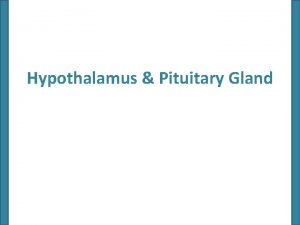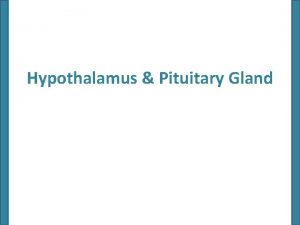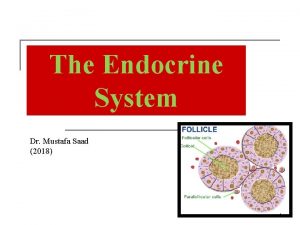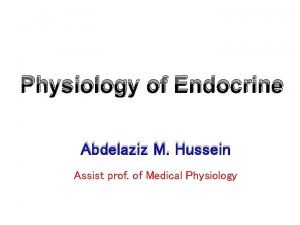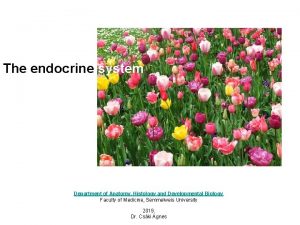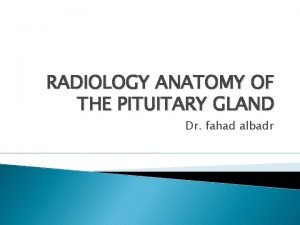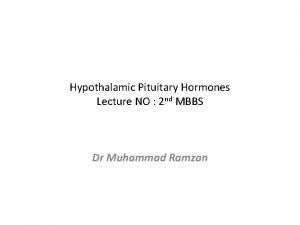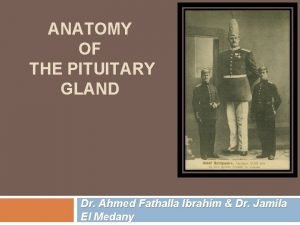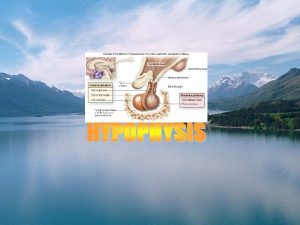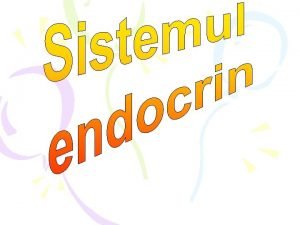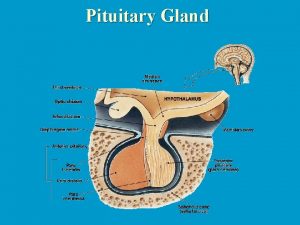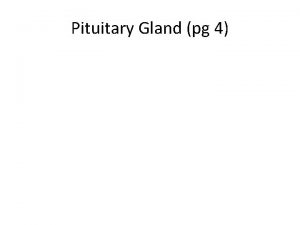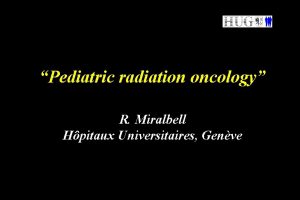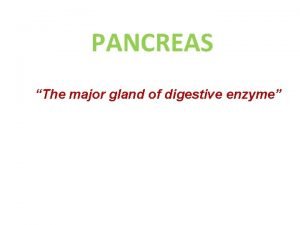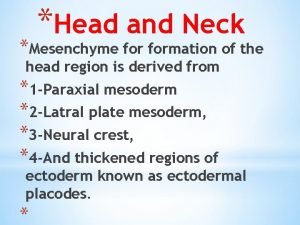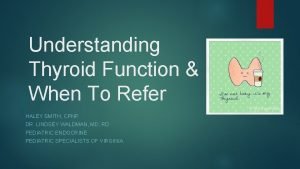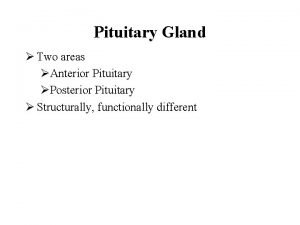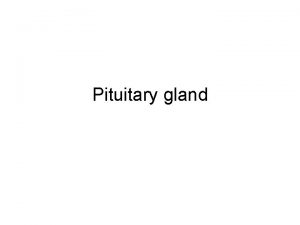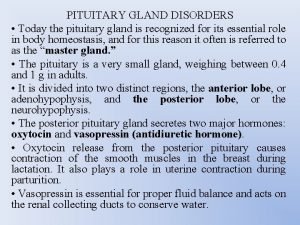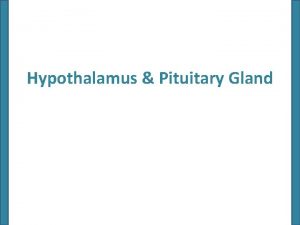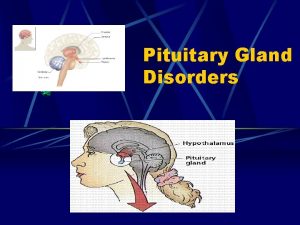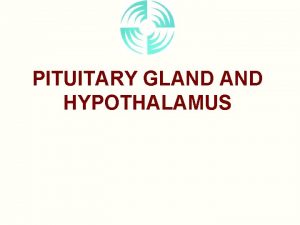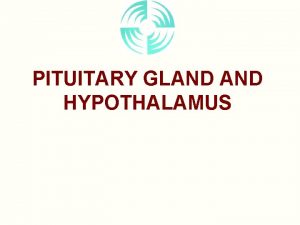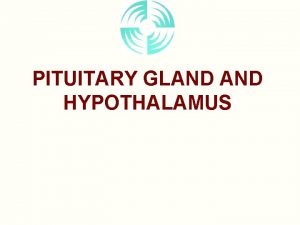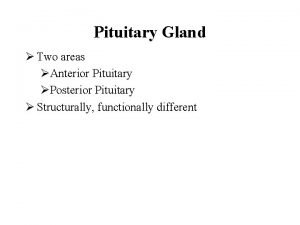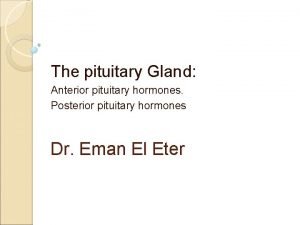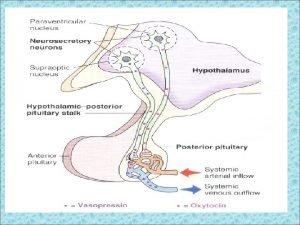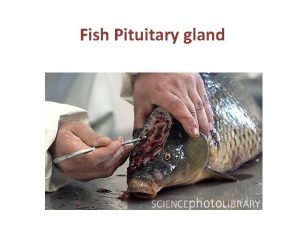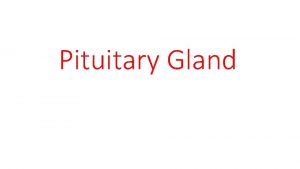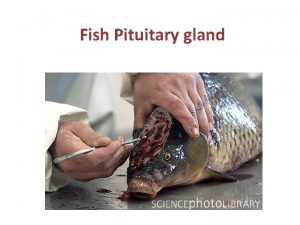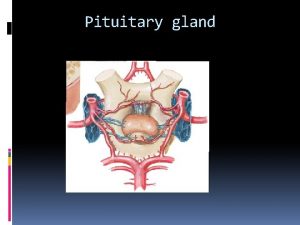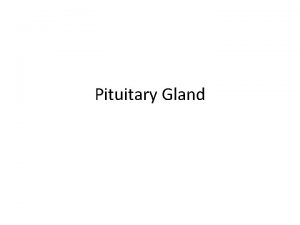Pituitary Gland Hypothalamus Hypothalamus and Pituitary Gland The

























- Slides: 25

Pituitary Gland & Hypothalamus

Hypothalamus and Pituitary Gland • The hypothalamus and pituitary gland work together to control other endocrine glands. • They are connected by the infundibulum. Copyright © 2014 John Wiley & Sons, Inc. All rights reserved.


Pituitary Gland • Master Gland – Controls growth & activity of the Thyroid Gland, Adrenal Gland, Gonads, & Liver • “Middleman” between the brain (CNS) and the peripheral endocrine organs • Pituitary hormones act on endocrine and nonendocrine tissue • Located outside the blood-brain barrier

Pituitary Gland • Anterior lobe (adenohypophysis) – Comprises 75% of the weight of the pituitary gland – Secretes 7 hormones. • Posterior lobe (neurohypophysis) – Made of neural tissue – Releases two hormones/neuropeptides made by the hypothalamus. 1. Oxytocin 2. Vasopressin/ADH Copyright © 2014 John Wiley & Sons, Inc. All rights reserved.

Hypothalamus • Secretes releasing and inhibiting hormones that control the release of hormones by the pituitary gland. • They reach the pituitary gland via the hypophyseal portal system.

Hypophysiotropic Hormones Copyright © 2014 John Wiley & Sons, Inc. All rights reserved.

Hypophyseal Portal System Copyright © 2014 John Wiley & Sons, Inc. All rights reserved.

Anterior Pituitary - Trophic Hormones 1. 2. 3. 4. 5. 6. 7. Human Growth Hormone - h. GH Thyroid-Stimulating Hormone - TSH Follicle-Stimulating Hormone - FSH Luteinizing Hormone - LH Prolactin - PRL Adrenocorticotropic Hormone - ACTH Melanocyte-Stimulating Hormone - MSH

Human Growth Hormone (h. GH/GH) a. k. a. Somatotropin • Most abundant AP hormone • Produced by somatotrophs • Account for majority of cells present in AP • 1° - acts on liver (IGF) • GHRH stimulates; SST/GHIH inhibits


h. GH Feedback Loops Copyright © 2014 John Wiley & Sons, Inc. All rights reserved.

Thyroid-Stimulating Hormone (TSH) a. k. a. Thyrotopin • Produced by thyrotrophs • 1°- acts on thyroid (T 3/T 4). In mammals thermogenesis • Stimulated by TRH

Follicle-Stimulating Hormone (FSH) a. k. a Follitropin • Produced by gonadotrophs • Specifically, FSH-gonadotroph • 1°- in men: promotes spematogenesis; in women: follicular growth (estrogen/progesterone) • Stimulated by Gn. RH

Luteinizing Hormone (LH) a. k. a. Lutropin • Produced by gonadotrophs • Specifically, LH-gonadotroph • 1° - in men: acts on testes (testosterone); in women: acts on ovaries (ovulation/CL) Stimulated by Gn. RH

Prolactin (PRL) • Produced by lactotrophs • A. k. a. mammotrophs • PRL increases during pregnancy and reaches maximal values at parturition • Milk production in post-partum women • Stimulated by nursing infant

Adrenocorticotropic Hormone (ACTH) a. k. a. Corticotropin • Produced by corticotrophs • 1° action- stimulates steroid biosynthesis within the adrenal cortex; cortisol • Stimulated by CRH • High cortisol = Cushings Disease • Low cortisol = Addisons Disease

Melanocyte-Stimulating Hormone (MSH) a. k. a. Melanotropin • Produced by corticotrophs • Disperse melanin pigment in melanocytes in the skin • Not secreted in large amounts by AP

Credit: Dr. Michael Ormsbee, Florida State University

Hypothalamus and A. P. Negative feedback loops control the secretions of: • Thyrotrophs • TSH • Gonadotrophs • LH, FSH • Corticotrophs • ACTH, MSH Copyright © 2014 John Wiley & Sons, Inc. All rights reserved.

Posterior Pituitary • The posterior pituitary gland does not synthesize any hormones. • It stores and releases from axon terminals two hormones: – oxytocin (OT) – anti-diuretic hormone (ADH)/vasopressin • Axons from the neurosecretory cells form the hypothalamohypophyseal tract. Copyright © 2014 John Wiley & Sons, Inc. All rights reserved.

Hypothalamus and Post. Pituitary Copyright © 2014 John Wiley & Sons, Inc. All rights reserved.

Posterior Pituitary - ADH • Antidiuretic hormone (ADH)/vasopressin – Amount secreted varies with blood osmotic pressure. – Its function is to decrease urine output. – Osmoreceptors (neurons) in the hypothalamus monitor blood osmotic pressure. ↑ blood volume causes ↓ ADH secretion ↓ blood volume causes ↑ ADH secretion Copyright © 2014 John Wiley & Sons, Inc. All rights reserved.

ADH Feedback Loop Copyright © 2014 John Wiley & Sons, Inc. All rights reserved.

Posterior Pituitary - Oxytocin • The “cuddle” or “love” hormone • Active during parturition and post-partum Stretching of cervix = ↑↑ oxytocin release Results in ↑ smooth muscle contractions of uterus After birth – responsible for milk letdown/ejection Copyright © 2014 John Wiley & Sons, Inc. All rights reserved.
 Hyposecretion of prolactin
Hyposecretion of prolactin Hypothalamus and pituitary gland connection
Hypothalamus and pituitary gland connection Embryonic development of pituitary gland
Embryonic development of pituitary gland Pituitary gland and pineal gland spiritual
Pituitary gland and pineal gland spiritual Thyoid gland
Thyoid gland Hypophyseal fossa and pituitary gland
Hypophyseal fossa and pituitary gland Hypophyseal fossa and pituitary gland
Hypophyseal fossa and pituitary gland Hypophyseal fossa and pituitary gland
Hypophyseal fossa and pituitary gland Endocrine organ
Endocrine organ Normal pituitary gland
Normal pituitary gland Division of pituitary gland
Division of pituitary gland Pituitary gland anatomical relations
Pituitary gland anatomical relations Hyperfunction of the pituitary gland in preadolescence
Hyperfunction of the pituitary gland in preadolescence Morphology of pituitary gland
Morphology of pituitary gland Posterior pituitary blood supply
Posterior pituitary blood supply Blood supply of pituitary gland
Blood supply of pituitary gland Prolactin hormones
Prolactin hormones Pituitary gland hormones
Pituitary gland hormones Brainstem glioma
Brainstem glioma Where is kidney pain felt diagram
Where is kidney pain felt diagram Tuberculum impar
Tuberculum impar Subdivision of pituitary gland
Subdivision of pituitary gland Pituitary gland thyroid
Pituitary gland thyroid Anterior pituitary
Anterior pituitary The embryonic origin of the anterior pituitary gland is
The embryonic origin of the anterior pituitary gland is Pituitary gland disorders
Pituitary gland disorders
